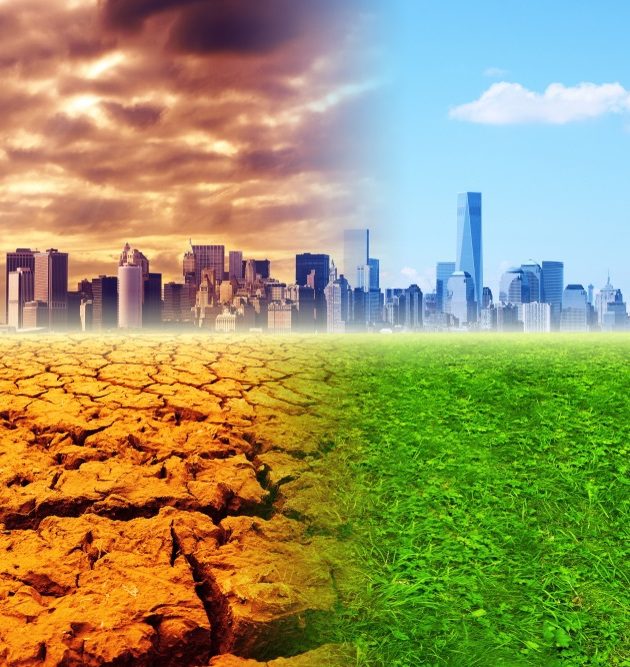Change in global climate patterns has bought intense discourse in the scientific community, intelligentsia, and the industry leaders alike. Legislations are being enacted and agreements are being signed. An air of hope reigns among the torchbearers. As António Guterres, Secretary-General UN remarked, “the climate emergency is a race we are losing, but it is a race we can win!”
Although climate change and change in weather patterns are a complex science, Carbon dioxide (CO₂) emission is the alter ego of modernization. Increased industrial and commercial development over decades have been producing CO₂ emissions in billions of tons. Usage of coal, oil, and natural gas has been affecting the Earth’s atmosphere and its fragile ecosystem.

China with 28 per cent is the largest stakeholder in global CO₂ emissions, followed by the USA with 15 per cent, and India with 7 per cent. The chart above has been compiled by the International Energy Agency, estimating carbon dioxide (CO₂) emissions from the combustion of coal, natural gas, oil, and other fuels, including industrial and non-renewable municipal waste.
Interestingly, the per capita emission rankings tell a different story. According to 2018 rankings the International Energy Agency (IEA) placed Saudi Arabia on the top with 18.48 Tons followed by Kazakhstan (17.60 T) and Australia (16.92 T). The United States comes fourth with (16.56T), China at 13th position (7.05T) and India placed at 21st with 1.96 T of per capita CO₂ emission.
The picture that emerges out from these findings is paradoxical.
Such uneven contributions towards climate crisis are the challenges faced by the scientific community to engineer an effective and equitable solution to global warming.
The COP26 Summit held recently at Glasgow came up with some long-awaited outcomes.
In the keynote during the summit, it was reiterated and announced that the gap would be reduced and efforts would be made towards limiting the rise in temperature to 1.5°C (2.7°F).
The key players agreed to show urgency and deliver more resources, aiding climate-vulnerable nations to adapt to the menacing and costly consequences brought by the rapid changes in the world weather system.
India, endorsing its position, announced that it would reach net-zero emissions by 2070. A commitment backed up with near-term targets (including ambitious renewable energy targets for 2030), as many as 109 countries signed up to cut emissions by 30 per cent by 2030 as part of the Global Methane Pledge.
The United Nations, the WHO, major governments across the world, legislative bodies, municipal corporations, corporate sectors et al. are trying their level best in toeing the line per se COVID-19 (pandemic). Keeping this in mind, the UN Secretary-General proposed the following climate-positive actions. Three out of six prepositions are all green— Green transition: all aspects of the economy must be decarbonized. Investments must be accelerated to achieve this goal. Green jobs for sustainable and inclusive growth would be promoted, in line with adoption of a green economy. Furthermore, he asserted that the practice of giving subsidies on fossil fuel be ended. Causes of pollution must be discouraged, and sometimes be penalized. All plausible risks upon climate must be confronted with and finally, no nation can succeed alone. Every member must participate and cooperate.
Let us revisit the previous century in retrospection. After a brief lull around, the post-war economic boom began somewhere in the early fifties.
The speed and expanse of industrial development and those related to reconstruction, the period popularly known as the ‘Golden Age of Capitalism’, laid foundations of the World that we are living in today.
The accelerated pace of the modern life and expansion of economies, especially in the past century or so, could not have been possible without the discovery of crude oil. It took many decades, however, to understand what would be its repercussions.
Over the years amidst growing global concerns, coupled with scope for business and technological innovations, eco-friendly technologies are being evolved to address climate change, specifically global warming. Here are some examples:
- Carbon capture technology: This technology traps carbon dioxide emissions at the source and funnels the gas to a storage installed deep beneath the earth. This aims to ensure zero CO2 emission.
- Feeding seaweed to cows: This is a unique proposition that considerably is reducing methane gas emission from burping cattle. Methane is released due to a peculiarity, the way cow digests food. Scientists have discovered that a red seaweed found in the tropics that can reduce such emissions by over 80 per cent.
- Alternative to beef: To further reduce methane emission, protein-rich insects such as mealworms are thought to be promoted as an alternative to beef. This can be done without the demand of on-land or on-water farming required for cattle. Apart from proteins, these insects carry many other nutrients, including the much-needed iron.
- Climate repair: One of the ideas the University of Cambridge currently investigating is refreezing the Arctic and Antarctica. The plan is to brighten clouds above the poles. Tiny drops of salt sprayed into the sky will help clouds reflect radiation into the space. Fertilization of marine plant life is another idea in the offing. Multiplying growth of plant matter and algae could absorb more carbon dioxide.
- Remote working: The COVID-19-induced pandemic, despite being a bane, taught us many things. Work from home (WFH) is one among many disruptions that has become part of the new normal. For the record, rush-hour traffic and running large office buildings are major contributors to CO2 and related emissions.
How can entrepreneurs engage in solving the climate crisis?
Combating climate change is complex, challenging, and larger-than-life.
Young entrepreneurs are among the undisputed change-agents who can provide a catalyst to combat climate change and help achieve the 2030 Agenda for Sustainable Development.
Besides building a profit-oriented venture, entrepreneurs have started taking pride in enabling a greener and more sustainable ecosystem.
Entrepreneurs can build their businesses around one or many of the four most desired domains for climate change. These are
- Renewable Energy
- Circular Economy and Waste Management
- Sustainable Agriculture and Aquaculture
- Sustainable Forest Management.
These entrepreneurial opportunities, though, are not without risks and challenges just like any other ventures. The three most common barriers in scaling up and ensuring sustainability seem to be
- Less supportive regulatory frameworks
- Non-availability of easy financial resources
- Capacity limitations
For a more inclusive business model encouraging sustainable growth, one must involve local people, specifically women, and small and marginal farmers. They are the custodians of their landscapes. They possess the knowledge of local ecosystems which can help make the actions for climate change become effective and sustainable.
The key foundation to enhance climate resilience should base on the leadership, knowledge, and value of these groups and communities.
The core of such a venture must imbibe strategically aligned Sustainable Development Goals (SDGs) as the blueprint to ensure adequate funding in areas such as low carbon initiatives, renewable energy, sustainable natural resource management, biodiversity, and other relatable goals.
Funding Climate Tech
Estimates show that India-based ventures received over One Billion USD in VC funding between 2016 and 2021. A report published by London & Partners and ‘Dealroom’ ranks India ninth globally for climate tech investments.
Though VC funding in this area accounts for a mere 6 per cent as compared to other businesses, global funding towards climate tech crossed 450 billion USD in September 2021 as per Pitchbook.
It can be worthwhile throwing some light on a few India-based Climate Tech ventures.
Log 9 Materials, a Bangaluru based nanotechnology startup is contributing towards zero-emission and low-cost aluminum-air fuel cells. Founded by Kartik Hajela and Akshay Singhal in 2015, they use Graphene; a carbon-based material. The company possesses 16 patents around Graphene. This fuel cell can be used for stationery as well as automotive energy applications.
The company raised 3.5 M USD in October 2020 through Surge and Exfinity Venture Partners.
Oxygarden: Ever considered breathing dust-free unpolluted air in your own home? OxyGarden Indoor Air Quality Solutions, a Gurugram-based start-up just thought of a solution. It developed an IoT-enabled garden that purifies homes, keeps them free from bacteria, viruses and toxic chemical pollutants like; carbon monoxide, benzene, formaldehyde, etc. in an enclosed space.
It took two years of testing and prototyping before the startup came up with ‘Forest’— a soilless garden.
Abhishek Gupta, a serial entrepreneur, founded OxyGarden in early 2019.
He raised a seed fund of USD 70,000 in late 2019. He is reportedly looking forward to closing a 150,000 USD investment deal soon.
Nature-Fix Climate (NFC) Ventures, a Bangaluru based fund is all set to receive a 100 M USD deal by March 2022. By the end of December, its total funding shall add up to 200 million. The funding period shall run for 12 years, the first five earmarked for investments and the rest for follow-ons and exits.
As countries continue to experience catastrophic flooding, wildfires, and storms, confronting the climate-induced challenges feels more essential than ever. In 2020, the United States alone had a record 22 weather and climate disasters with damages of 1 billion USD in a conservative estimate.
The venture capital industry seems to be extremely active this year for a variety of reasons. Partly it stems from VCs’ sense of urgency over the climate change related concerns. But there has also been more enthusiastic flow of funds around which has never been the case.
This is not just about the venture capitalists. According to Morningstar, institutional investors poured in 51 billion USD into funds primarily focused on sustainability, environment, and social good (ESG) in 2020, which was more than double of the amount channeled in the previous year.
Analyses say that the industry might produce up to 1,000 unicorns (businesses valued at USD 1 billion or more) within the next few years. For the record, between 2013 and 2019, the returns on investments in climate-tech were five times higher on an average.
It seems the coming years will bring greater scheme of things for young entrepreneurs, investors, and the planet alike.



2 comments
Meghna
December 13, 2021 at 4:08 pm
Very apt article must read for all. As climate change is a looming threat to the mother Earth and survival of us humans. Going green is the only option that we must embrace.
Sushil Joshua
December 17, 2021 at 7:32 am
Excellent piece of information and very articulately explained.